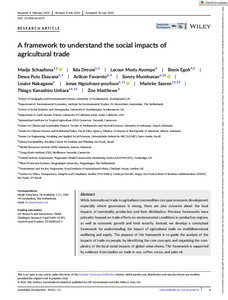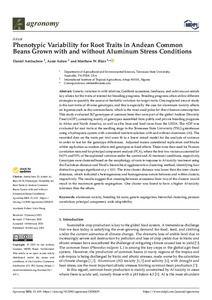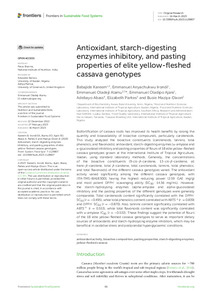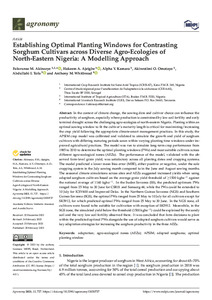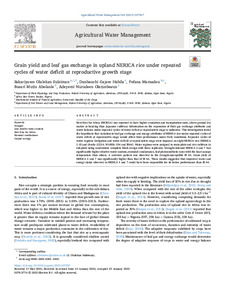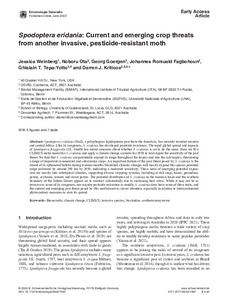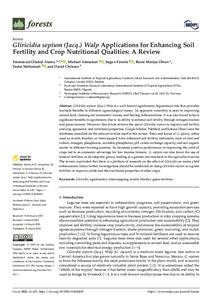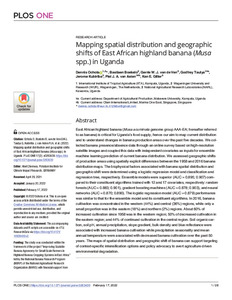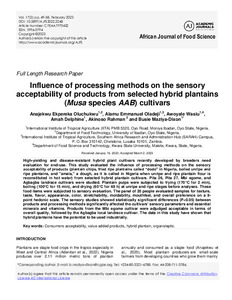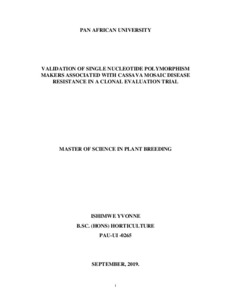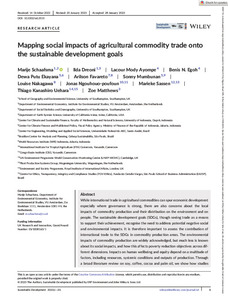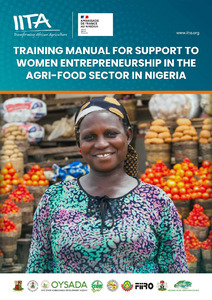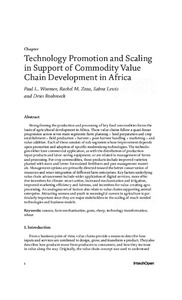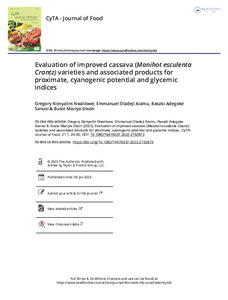Welcome to the International Institute of Tropical Agriculture Research Repository
IITA Bibliography System: Recent submissions
Now showing items 541-560 of 8094
-
Early planting of cassava enhanced the response of improved cultivars to potassium fertilization in South Kivu, Democratic Republic of Congo
(2023-05-15)Cassava is the most important crop in DRC, where it is both a staple and a cash crop. Over the last years, cassava productivity seems increasingly constrained by climate disturbances. To respond to these climatic disturbances, farmers opt to adjust the planting period to spread the risk by optimizing their chances to receive the most regular rainfall in the crucial first 100 days after planting. To investigate the potential of varying cassava planting time to mitigate the effect of changes in ... -
A framework to understand the social impacts of agricultural trade
(2022-08)While international trade in agricultural commodities can spur economic development especially where governance is strong, there are also concerns about the local impacts of commodity production and their distribution. Previous frameworks have primarily focused on trade effects on environmental conditions in production regions, as well as economic growth and food security. Instead, we develop a conceptual framework for understanding the impact of agricultural trade on multidimensional wellbeing ... -
Genetic studies of fall armyworm indicate a new introduction into Africa and identify limits to its migratory behavior
(2022-02)The fall armyworm, Spodoptera frugiperda (J.E. Smith) is native to the Americas and a major pest of corn and several other crops of economic importance. The species has characteristics that make it of particular concern as an invasive pest, including broad host range, long-distance migration behavior, and a propensity for field-evolved pesticide resistance. The discovery of fall armyworm in western Africa in 2016 was followed by what was apparently a remarkably rapid spread throughout sub-Saharan ... -
Phenotypic variability for root traits in Andean common beans grown with and without aluminum stress conditions
(2023-02-22)Genetic variation in wild relatives, GenBank accessions, landraces, and cultivars can unlock key alleles for the traits of interest for breeding programs. Breeding programs often utilize different strategies to quantify the source of heritable variation for target traits. One neglected area of study is the root traits of diverse genotypes, and this is especially the case for aluminum toxicity effects on legumes such as the common bean, which is the most used pulse for direct human consumption. ... -
Sustainable information technology practice in libraries
(IGI Global, 2023-01)Information technology is a crucial tool required for the growth of all sectors in any nation. Undoubtedly, its application in libraries contributes significantly to meeting people’s information needs since libraries are essential in providing information services to information seekers. Thus, a well-organized library should have sustained information technology to assist in providing correct and timely services to its patrons. This chapter used current and relevant research findings and papers ... -
Antioxidant, starch-digesting enzymes inhibitory, and pasting properties of elite yellow-fleshed cassava genotypes
(2023-03-16)Biofortification of cassava roots has improved its health benefits by raising the quantity and bioavailability of bioactive compounds, particularly carotenoids. This study analyzed the bioactive constituents (carotenoids, tannins, total phenolics, and flavonoids), antioxidant, starch-digesting enzymes (a-amylase and a-glucosidase) inhibitory and pasting properties of flours of 18 elite yellow-fleshed cassava genotypes grown at the International Institute of Tropical Agriculture, Ibadan, using ... -
Establishing optimal planting windows for contrasting sorghum cultivars across diverse agro-ecologies of north-eastern Nigeria: a modelling approach
(2023-02-28)In the context of climate change, the sowing date and cultivar choice can influence the productivity of sorghum, especially where production is constrained by low soil fertility and early terminal drought across the challenging agro-ecologies of north-eastern Nigeria. Planting within an optimal sowing window to fit the cultivar’s maturity length is critical for maximizing/increasing the crop yield following the appropriate climate-smart management practices. In this study, the APSIM crop model was ... -
Grain yield and leaf gas exchange in upland NERICA rice under repeated cycles of water deficit at reproductive growth stage
(2022-04)New Rice for Africa (NERICA) was reported to have higher exudation and transpiration rates, above ground dry matter at heading than Japanese cultivars. Information on the expression of their gas exchange attributes and water balance under repeated cycles of water deficit at reproductive stage is unknown. This investigation tested the hypothesis that variation in leaf gas exchange and energy attributes of NERICA rice under repeated cycles of water deficit at reproductive stage would affect their ... -
Spodoptera eridania: current and emerging crop threats from another invasive, pesticide-resistant moth
(2022-10-25)Spodoptera eridania (Stoll), a polyphagous lepidopteran pest from the Americas, has recently invaded western and central Africa. Like its congeners, S. eridania has developed pesticide resistance. The rapid global spread and impacts of Spodoptera frugiperda (J.E. Smith) has raised concerns about whether S. eridania is set to do the same. Here we fit a CLIMEX niche model for S. eridania and apply a climate change scenario for 2050 to investigate the sensitivity of the pest threat. We find that S. ... -
Maize resistance to witchweed through changes in strigolactone biosynthesis
(2023-01)Maize (Zea mays) is a major staple crop in Africa, where its yield and the livelihood of millions are compromised by the parasitic witchweed Striga. Germination of Striga is induced by strigolactones exuded from maize roots into the rhizosphere. In a maize germplasm collection, we identified two strigolactones, zealactol and zealactonoic acid, which stimulate less Striga germination than the major maize strigolactone, zealactone. We then showed that a single cytochrome P450, ZmCYP706C37, catalyzes ... -
Gliricidia sepium (Jacq.) walp applications for enhancing soil fertility and crop nutritional qualities: a review
(2023-03-21)Gliricidia sepium (Jacq.) Walp is a well-known agroforestry leguminous tree that provides multiple benefits in different agroecological zones. Its apparent versatility is seen in improving animal feed, cleaning environmental wastes, and healing inflammations. It was also found to have significant benefits in agroforestry due to its ability to enhance soil fertility through nitrogen fixation and green manure. However, this article reviews the use of Gliricidia sepium to improve soil fertility and ... -
Mapping spatial distribution and geographic shifts of east African highland banana (Musa spp.) in Uganda
(2022-02-17)East African highland banana (Musa acuminata genome group AAA-EA; hereafter referred to as banana) is critical for Uganda’s food supply, hence our aim to map current distribution and to understand changes in banana production areas over the past five decades. We collected banana presence/absence data through an online survey based on high-resolution satellite images and coupled this data with independent covariates as inputs for ensemble machine learning prediction of current banana distribution. ... -
Influence of processing methods on the sensory acceptability of products from selected hybrid plantains (Musa species AAB) cultivars
(2023-02)High-yielding and disease-resistant hybrid plant cultivars recently developed by breeders need evaluation for end-use. This study evaluated the influence of processing methods on the sensory acceptability of products (plantain chips, fried ripe plantains called “dodo” in Nigeria, boiled unripe and ripe plantains, and "amala," a dough, as it is called in Nigeria when unripe and ripe plantain flour is reconstituted in hot water) from selected hybrid plantain cultivars. Pita 26, Pita 27, Mbi egome, ... -
Validation of single nucleotide polymorphism makers associated with cassava mosaic disease resistance in a clonal evaluation trial
(University of Ibadan, 2019-09)Cassava is an important staple crop in Africa for almost half of the population. The main biotic constraint of the crop is Cassava Mosaic Disease (CMD) which causes significant losses on farmers’ field. The conventional screening for CMD resistance in new cassava populations is time-consuming, expensive and not highly reliable. However, there are newly developed Single Nucleotide Polymorphism (SNP) markers linked to CMD resistance which have not been validated. Therefore, the objective of this ... -
Response of cocoa (Theobroma cacao L.) seedlings to folia fertilizer application and fertigation
(Kwame Nkrumah University of Science and Technology, 2023-03)The production of quality and vigorous seedlings is important for sustainable cocoa production. A greenhouse nursery study was conducted in 2019/2020 at CRIG to assess the effects of foliar fertilizer application and fertigation on soil chemical properties, nutrient uptake and growth of cocoa seedlings. The study was 4x3 factorial experiment, laid out in completely randomized design with 13 treatments and three replicates. Two liquid fertilizers (NPK 24:17:18 and NPK 10:10:10) and two granular ... -
Mapping social impacts of agricultural commodity trade onto the sustainable development goals
(2023-02-07)While international trade in agricultural commodities can spur economic development especially where governance is strong, there are also concerns about the local impacts of commodity production and their distribution on the environment and on people. The sustainable development goals (SDGs), though seeing trade as a means to support their achievement, recognise the need to address potential negative social and environmental impacts. It is therefore important to assess the contribution of international ... -
Training Manual for Support to Women Entrepreneurship in the Agri-Food Sector in Nigeria (SWEAN)
(IInternational Institute of Tropical Agriculture, 2022)The paradigm shifts from a supply-driven intervention to a more responsive demand-drive intervention necessitates the fulfillment of the sociological approach. This approach advocates that the needs of beneficiaries be ascertained before any intervention is carried out. Consequently, the training needs of women agri-preneurs were identified in Ibadan and Zaria of Oyo and Kaduna states, respectively during the inception of the Support to Women Entrepreneurship in the Agrifood sector in Nigeria ... -
Technology promotion and scaling in support of commodity value chain development in Africa
(IntechOpen, 2023-03-07)Strengthening the production and processing of key food commodities forms the basis of agricultural development in Africa. These value chains follow a quasi-linear progression across seven main segments: farm planning > land preparation and crop establishment > field production > harvest > post-harvest handling > marketing > and value addition. Each of these consists of sub-segments whose improvement depends upon promotion and adoption of specific modernizing technologies. The technologies either ... -
Impact of improved hermetic storage on food insecurity and poverty of smallholder cowpea farmers in northwestern Nigeria
(2023-12-07)Postharvest loss of cowpea grains due to insect pests like cowpea bruchids is a common problem in Nigeria and has often exacerbated the food insecurity and poverty of households. In a bid to protect their cowpea grains, farmers’ indiscriminate use of insecticides (often misused and overused) has had a negative impact on human health and the environment. Efforts to promote the use of non-chemical hermetic storage have sought to address the issue. This study, therefore, examined the impact of a ... -
Evaluation of improved cassava (Manihot esculenta Crantz) varieties and associated products for proximate, cyanogenic potential and glycemic indices
(2023-01-05)This study investigated the proximate, cyanide, and glycemic indices of roots and eba (gari dough) made from improved cassava cultivars. Twenty cassava cultivars were obtained from the IITA research farms and analyzed for proximate and carbohydrate compositions and cyanogenic potential using standard procedures. Afterward, four cassava varieties were selected using the agglomerate hierarchical cluster analysis. The selected varieties were processed into gari and reconstituted in hot water into ...


